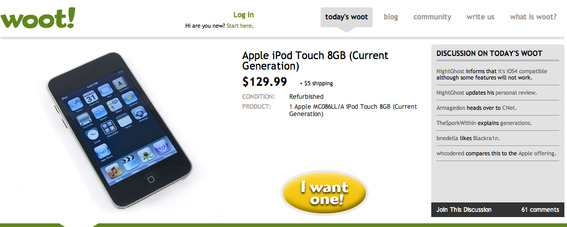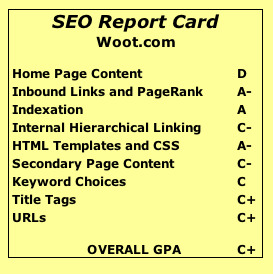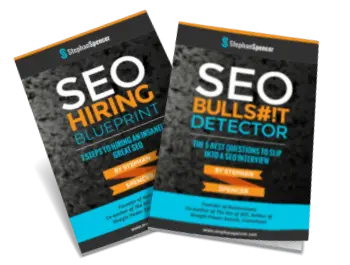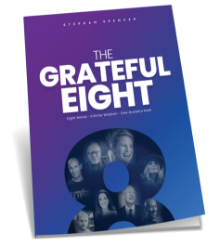This article was originally published under Practice Ecommerce.
For this month’s “SEO Report Card,” I thought I would do something different and review a site that didn’t request it. The site I chose, Woot.com, is near and dear to my heart. I’m an avid Wooter, and have been for the last few years.

What’s Woot.com?
Woot.com is a very special ecommerce site: It sells only one product per day. Granted it has several spin-off sites now, such as Wine.woot.com and Shirt.woot.com, but still the premise across the main site and the spin-offs remains the same: Only one product is for sale on a given day, and when that product sells out, there is nothing else to sell–at least not until midnight Central Time (U.S.), when the next day’s product is unveiled. (There are exceptions, as any Wooter will tell you, like when there is a Woot-off.) It’s brilliant marketing that uses scarcity to drive impulse purchases. Speaking from experience as a Woot customer, I’ve been way too impulsive way too often.
Woot’s been in the news lately. It was just acquired by Amazon, if you hadn’t already heard. This was really the impetus for me to feature it in this month’s “SEO Report Card.” Amazon.com is arguably one of the best-optimized ecommerce sites on the planet. And yet Woot.com sits on the other end of the spectrum. Dare we call it anti-SEO?
Home Page, Secondary Pages
Woot’s unique business model poses a significant challenge for search engine optimization. There is no online catalog full of SKUs to present to the search engines. Nor is there an array of categories and sub-categories with keyword themes to target. Even the home page is lacking a stable keyword theme. The home page is where the day’s deal is presented, so the entire page copy changes out every night at midnight. So what’s there to optimize? Plenty. Specifically, thousands of blog posts and tens of thousands of discussion forum posts, the latter being user-generated content that Woot didn’t even have to pay for. Each of these pages is sitting in Google’s index, ready and waiting to deliver searchers to Woot’s door. Unfortunately, most of these pages aren’t currently targeting any keyword themes. At least there’s nothing worth targeting. (What do you reckon “Woot: The Community: Woots: Random Crap” is targeting?)
What’s the point of attracting a Google searcher to the site from a months-old blog post that talks about a product that is no longer available for sale? The point is to get this prospect onto Woot’s list. Once the prospect is on their list, Woot has permission to start and maintain a dialogue with that prospect, and to turn him or her into a rabid fan. Every blog post, indeed every page of the site, should be treated like it’s a “squeeze page.”
Keyword Choices
What would be “head” terms for Woot? “Deals” and related keywords like “last minute deals.” I don’t think “bargains” is as good as “deals,” but it’s a decent candidate. Perhaps even “electronics” and/or “gear.” The home page should be retooled so that it targets one or more of these head terms as its keyword focus. (“Last minute deals and bargains in electronics and gear,” for instance.) Right now, the primary keyword focus for the home page is its brand name and its tag. It’s unnecessary to target the “Woot” brand as a keyword focus because it’s impossible for Woot.com to not rank number 1 for that keyword, due to the strength of its domain authority and the “Woot” containing anchor text of the inbound links. And, of course, no one searches for a company’s tagline, except perhaps for the company’s CEO.
Title Tags
Incidentally, the first word of every title tag is “Woot” across the entire site. This I would definitely change; it’s prime wasted real estate that should be occupied by the page’s primary keyword theme.
How about “Long Tail” terms? There are plenty of those to target. Any product that they had sold in the past and blogged about, like “Motorola hs820 bluetooth headset” would be a good candidate. Woot’s already is doing a reasonable job targeting names of past-featured products in title tags. Too bad these pages are dead-ends that don’t compel the searcher to do anything but hit the back button.
“Torso” terms are in between the head and the Long Tail–not quite popular enough to be considered a head term, but not esoteric and rarely searched for, either. A great example of this would be “roomba,” an oft-returning product to Woot.com that no self-respecting geek should be without. (It’s a robot vacuum cleaner.)
Now that Amazon owns Woot, it makes even more sense that it ranks for terms such as “roomba” because it can direct incoming search traffic to the Roomba category on Amazon (as well as any related deals listed on the Deals.woot.com aggregator site).
Summary
In all, the Woot.com site is a diamond in the rough–with a ton of textual content (the prose is some of the funniest you’ll ever see on an ecommerce site). In my view, that content could easily be tweaked to drive much more search traffic and many more conversions, such as opt-ins, if not actual purchases.
SEO Report Card
WOOT.COM
Home Page Content D
Inbound Links and PageRank A-
Indexation A
Internal Hierarchical Linking Structure C-
HTML Templates and CSS A-
Secondary Page Content C-
Keyword Choices C
Title Tags C+
URLs C+
OVERALL GPA C+








